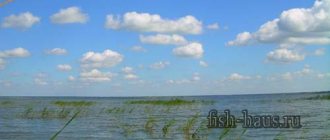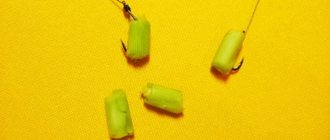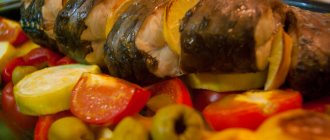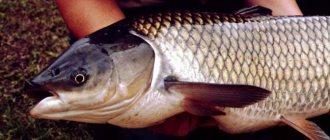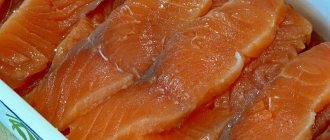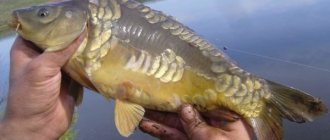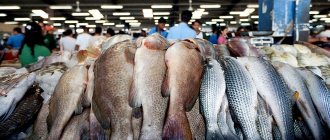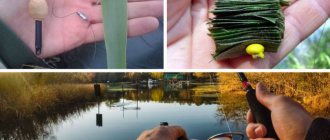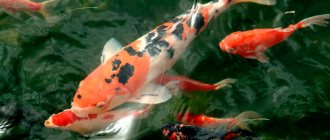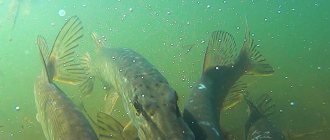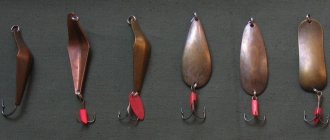The answer to the question of where to catch grass carp is more than obvious: you need to look for it where there is something for it to eat. Considering that this aquatic inhabitant is a pronounced vegetarian, it means that you need to look for it where there is a lot of greenery. But, despite its herbivory, it is most likely impossible to catch a carp while standing on the shore, since it is quite cautious. These are just some of the features of catching cupid; all other subtleties of this issue will be discussed further.
Description and behavior characteristics
Grass carp belongs to the carp family. The body of the fish is elongated and completely covered with scales. The main feature of this fish is that, unlike many other inhabitants of the water element, it grows very quickly.
If we talk about the taste characteristics of this fish, then most of all it likes to feast on plants of the highest category, these include soft grasses growing under water, reeds, as well as their shoots. For such a love of vegetation, she is often called the cow that lives under water. However, it should also be mentioned that the cupid chews all “accepted” food very carefully with its small, sharp teeth.
Thanks to its small head and compressed lips, the cupid can be called an elegant fish. Despite its love for herbs, cupid has a rather large and strong body. As for coloration: the back of the fish has a yellowish-gray tint, and the sides are silvery. Cupid is a fish with large scales, each individual link of these “sparkles” ends with a peculiar edging.
The fish most often lives in the middle of the body of water, in its thickness; when planning fishing, these features of the aquatic individual in question must be taken into account, then a rich bite will not be long in coming.
Grass carp - what kind of fish?
The homeland of grass carp is the Far East with its main habitat in the middle and lower reaches of the Amur, including the desalinated shelf of the Sea of Okhotsk. Fierce food competition with numerous representatives of char, salmon, sturgeon, and mullet forced the fish to completely switch to phytofeed, where there were fewer potential competitors: bighead carp (bighead), local forms of bream and chebak, black carp (Chinese roach). The latter is not a species relative of the belamur and forms its own genus (lat. Mylopharyngodon), which is on the verge of extinction in Russia, and in China is intensively bred in artificial fresh water bodies.
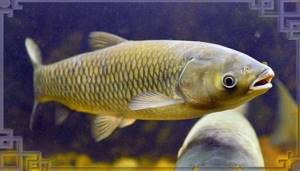
What does grass carp look like?
This species is quite easily identified by its non-standard appearance for representatives of the carp family:
- an elongated body of round cross-section (cylinder) with minimally pressed sides;
- small head with a strongly flattened forehead;
- the mouth with fleshy lips is directed downward;
- pectoral fins are placed close to the rear edge of the gill covers, decorated with radial stripes;
- rounded back dark olive or ash gray;
- eyes with golden irises;
- light belly;
- silvery or yellowish sides with large and tightly attached cycloid scales, which are characterized by smoothed edges (40-47 in a row).
In addition, the fish has a very short dorsal fin with 8-10 rays, inferior in size to the anal fin (11). The largest grass carp grows up to 120 cm and weighs 40 kg, but standard catches are dominated by young individuals (3-5 years old) weighing 2-6 kg.
To learn more:
Bream: description of fish, habitat and habits
Habitats
Grass carp is a fairly southern fish; it loves warm waters, so in most of our country (and this is the middle zone) it can only be found in artificial reservoirs that were created by human hands. It was mentioned above that cupid is a plant-loving fish, so you need to catch it in areas covered with various algae.
To accurately determine the habitat of the prey, you do not need to have special vigilance, since due to the fact that this fish, as a rule, spends a very long time at the surface of the reservoir, then traces, that is, excrement also remains from the carp there, you only need a little more show attentiveness.
Fishing calendar by fishing season
It was already mentioned above that grass carp is a heat-loving fish, so you can start catching it only in the second half of the calendar spring , when the water temperature warms up to 13-15°C. However, such a special feature of the aquatic reptile is explained not only by its heat-loving nature, but also by the fact that only at this time the water sources begin to fill with greenery.
Experienced fishermen recommend starting to fish for carp after the 15th of April; the best options for bait would be bloodworms, greens, and delicious worms.
The biggest bite on carp can be achieved on warm summer days . During this period, you should not rack your brains over the bait, since you can use almost anything that grows in the garden plot, for example, corn, various berries, as well as fresh cucumbers. , just picked.
The fishing season for white carp can continue until the fall , until the water in the river cools down.
The process of growing in a home pond
To productively raise young grass carp in an artificially created pond, breeders use various methods to increase breeding productivity, in particular, by using pituitary injections, further artificial insemination and incubation, not to mention the subsequent care of the emerging fry. Each of these stages has its own characteristics.
Important! Grass carp caviar is very sensitive to any mechanical influences, so in order not to crush it, all actions must be performed extremely carefully, having first placed a wide plastic bowl to collect future fry.
Pituitary injections
Injections from extracts obtained from the pituitary glands of carp and crucian carp best contribute to the stimulation of artificial spawning of grass carp. For one kilogram of live weight of fish, 2 mg of the substance is consumed for males, and 4 mg for females, divided into 2 injections: the first time they give only 10% of the prepared dose, and the second - the remaining 90% of the substance. After about a day, the eggs and sperm of the fish are filtered out. To perform these actions, 2 people are required: one holds the fish by the head and tail, and the second runs his hand in the direction from head to tail, as if squeezing the eggs out of an adult fish.
Video: pituitary injection and incubation of carp

Insemination and Incubation
Insemination of the resulting eggs should be carried out as carefully as their removal. The essence of the process is to mix the eggs with 4–6 ml of male carp sperm, after which water from the pond is poured into the resulting mixture, but always in 2 stages: first, no more than 150 ml per 1 liter of eggs, and after a minute another 100 ml. After 5 minutes, the water is drained and the caviar is washed until it begins to swell.
Also learn how to cook sagudai from pink salmon.
As soon as this happens, it is rinsed for the last time, achieving loss of stickiness, and after 1–1.5 hours (by this time the eggs usually reach the size of a black peppercorn) the material is sent to the Weiss apparatus. While in the device, the swelling of the caviar continues for another 4 hours, the main thing is that the water flows in it at a speed of at least 0.5 liters per minute.

Hatching of the larva
As soon as the larvae appear from the eggs placed in the Weiss apparatus, they are moved to a cage made of plastic fine mesh and sent to an artificial reservoir with a low water flow rate. The very next day after birth, almost all of them stay near the bottom, but due to lack of oxygen, many die. Dead larvae and egg shells remaining in the water must be immediately removed from the tray.
We recommend reading about recipes for fried pink salmon caviar.
After another day, the surviving representatives of grass carp are already confidently staying in the water column. The larvae spend 3–6 days in the container until they learn to hold well in a horizontal direction and feed fully. The grown fish along with the tray are moved into an artificial pond, and the plastic mesh is cleaned at least twice a day, ensuring unhindered free circulation of water.
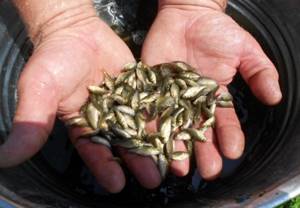
Top dressing
The natural food of the larvae for the first time after hatching is zooplankton, but if there is not enough such material at the place of their breeding, you will have to worry about a good replacement. The most nutritious mixture in this case is deservedly considered to be the version made from grated cottage cheese, boiled egg yolks and dried cyclops. Just 1 ml of such subcortex is enough for 100,000 larvae.
As a last resort, you can use finely ground ready-made granular food produced specifically for fry. As the fish grow, you can gradually switch to coarser feed mixtures. You can protect the larvae’s food from being washed away by the current and ensure easy control over its quantity by using feeders.
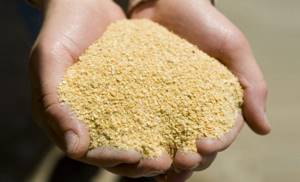
The first feeding after transplanting the young animals into the pond is carried out when the larvae are no more than 4-5 days old, and this is also true if there is a sufficient amount of the above-mentioned plankton. Instead of a curd-egg mixture, soybean meal mixed with water will also work at this time, the main thing is that the size of the grains is small and they float freely on the surface of the water for 35–40 minutes.
On average, they are filled once a day, selecting a specific diet based on the appetite of aquatic inhabitants. A sign of a properly selected menu is considered to be complete consumption of food within 8–10 hours after the next morning feeding. It will not be possible to see exactly how they will consume it, which is explained by the very small size of the larvae.
Important! The pond prepared for the larvae should be filled with water only immediately before they are launched, so that predatory insects do not have time to settle there. At the same time, try to calculate the time so that small plankton has already formed in the reservoir.
Conditions of detention
To grow and even reproduce in stagnant water, grass carp requires conditions close to its natural habitat. During the period of growing larvae, they are kept in fry ponds with an area of 100–200 m², which makes it easy to change the water and control the number of its inhabitants. If the fry are fed regularly, then after 20–30 days their body length will be 2-3 cm, which means you can move the young animals to nursery ponds ranging in size from 500 m² to 5 hectares, filled with liquid shortly before the young animals are moved.
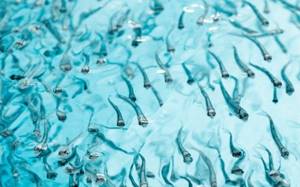
It is best if these are round pools, for each square meter of which there should be 200–300 larvae or 40–50 larger fry. The water temperature in fish habitats should not exceed +20°C.
Criteria for choosing gear
Grass carp is a fish that is far from small and quite weighty, so in order to get a rich catch you need to prepare in advance for this fascinating process. In this case, we are not talking about bait, but about fishing gear; they must be strong and durable in order to hold the fish caught on the hook.
Plug
This gear is practically designed for catching carp, as it creates the opportunity to accurately deliver the bait hanging on the hook to the aquatic inhabitant, and this is not so easy to do, considering that the favorite habitat of this fish is thick, barely passable algae .
The plug, due to its abilities, could be called an ideal device, if we lose sight of the rather high cost that fishermen have set today.
Match fishing rod
White carp can be caught without much effort using a match fishing rod; such tackle will simplify the task of landing this large fish.
At the same time, it is impossible not to mention that this aquatic inhabitant can live at very different depths of the river. In connection with these circumstances, the use of a fast, maneuverable and at the same time barely noticeable float for the fish itself is the key to successful fishing with a large and rich catch.
Feeder
Its use will bring success only in the spring, at a time when the water in the river has already become quite warm, but the vegetation has not yet had time to grow much. The ideal bait when using a feeder would be corn grains or boilies.
Young, recently born cupids, despite their vegetarian taste preferences, will not at all mind swimming to a hook with a maggot or worm. This live bait does not need to be cast to the very bottom; it is ideal to keep it in the middle water column.

Feeder equipment option
Successful fishing for carp on a feeder will only be in the spring; in the summer, this gear is not applicable, since it will simply get entangled in the grown aquatic vegetation.
Catching grass carp on a feeder
The object of fishing can only reproduce in its homeland - on the Amur River and in some of its tributaries. In central Russia the climate is somewhat different. There is no warm running water needed to raise offspring. That is why fishing for carp on the river is considered an unpromising activity, if not hopeless. You need to catch it on stocked fishing grounds and lakes, where the stock is regularly replenished with purchased fry.
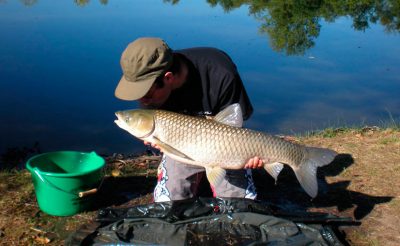
On a small body of water, problems with finding a promising place usually do not arise; there are not many of them there. In vast areas the opposite is true. Cupid does not stay in one place, it is in constant search of food and stops only in those areas where there is a lot of food. It would be stupid to chase him around the entire perimeter, so you will have to create a catch point yourself by feeding it correctly. At the same time, you need to understand that the closer to the shore it is, the less frequent and more careful the bites. It is advisable to “set the table” for the vegetarian away from the coastline so that he can grab the bait without any fear. In addition, large specimens are caught far from the shore, while in the coastal zone it is mostly small fish that bite. Trophy fish, of course, also enter shallow water to snack on juicy shoots of reeds, but they behave extremely carefully and at the slightest danger they flee to the depths. Alternatively, you can fish under the opposite bank, if the width of the reservoir and the range of the gear allow. The main thing is that there are no noisy colleagues on the other side.
Lure
The bait should be fine-grained and light, creating a lot of turbidity. Cupid will definitely come to look at this cloud and it is quite possible that he will be attracted by bait or plant bait. By the way, about bait. This topic causes constant controversy. It seems like there is plenty to choose from, starting with a worm and ending with cabbage leaves, but the results are not always pleasing.
The reason for the poor bite or lack thereof is that in each individual body of water the carp has its own taste preferences.
Hence the different opinions of fishermen: some say that it is necessary to fish with algae, while others assure that nothing is better than a young cucumber. If the lake is unfamiliar, you should take with you more different “dishes” and offer them to the capricious fish one by one.
Gear selection
The optimal feeder tackle for catching carp consists of the following elements:
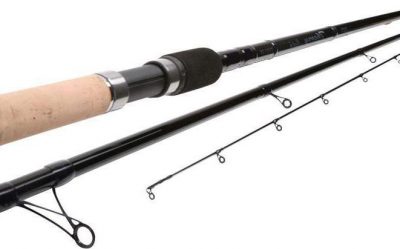
durable, reliable fishing rod 3.6 m long;- reels with spool 3000-3500 (spinless or multiplier);
- fishing line with a thickness of 0.3 to 0.5 mm (depending on the expected size of the fish);
- volumetric spring-type feeder;
- leash up to 50 cm long (slightly thinner than the main line);
- carp hook No. 5-8 according to domestic classification.
The best baits and lures
Having prepared the tackle, you should also think about the bait, only in this case the fish will certainly fall on the fisherman’s hook.
As for taste preferences, it has long been noted that cupid is especially partial to the sound of falling edible powder. Many experienced fishermen have repeatedly noticed that if the silence that has stood for a long time in the water surface is broken with a ball that can be eaten, then grass carp will soon notice it and get hooked. Therefore, when going fishing, you should not skimp on bait; you need to take it in large quantities.
When preparing “delicious rounds”, it is worth taking into account the fact that grass carp will swim up to it much faster if, in addition to the sound when it hits the water, it also leaves behind a trace in the form of a vertical column.
Animals
So, the following are ideal as animal baits:
- Earthworm or dung worm.
- Locust (loves very much).
- Livers of a wide variety of birds.
- Green grasshoppers.
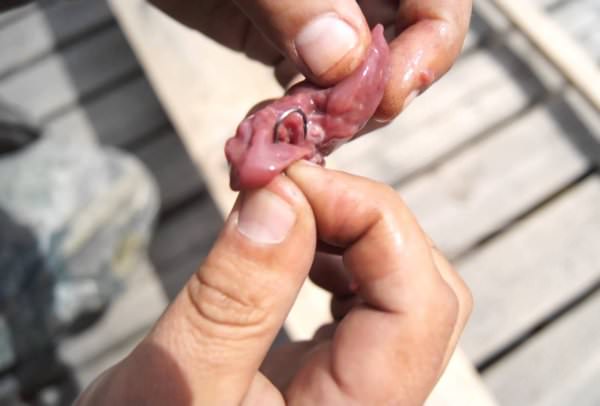
Liver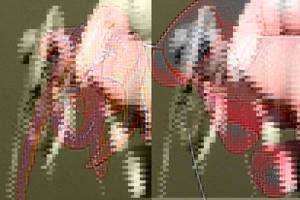
Crawls
Maggot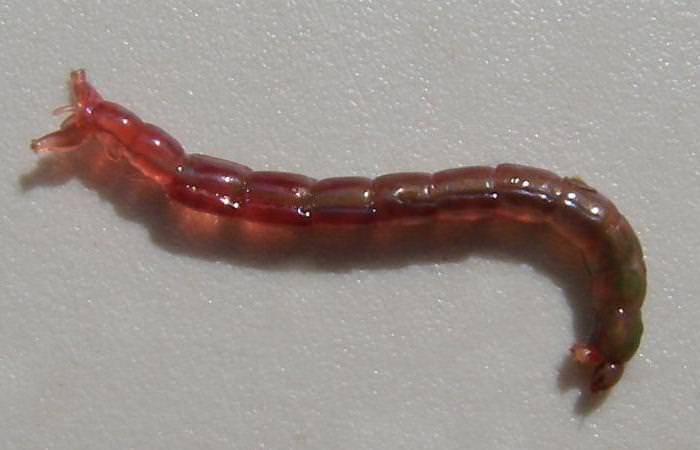
Bloodworm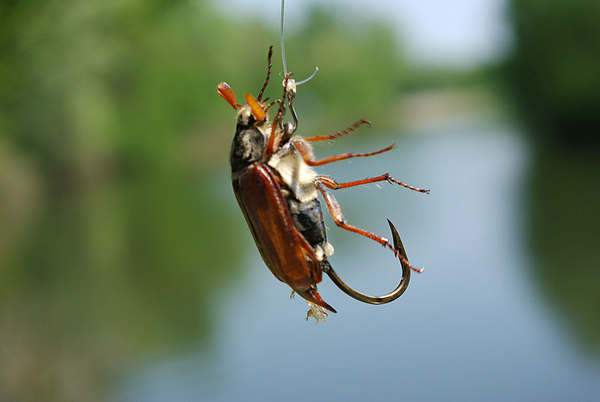
Chafer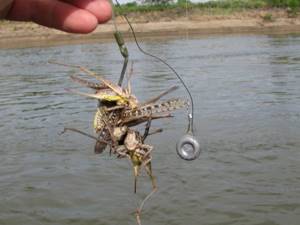
Locust - Maggot.
- Bloodworm.
- Crawling out.
All these baits, as well as greenery, will certainly attract an aquatic herbivore.
Vegetable
Amur is famous for its herbivory, but nevertheless it is worth on greens only in the second half of spring and at the very beginning of summer , at a time when nature is just awakening from its winter sleep.
During this period, the fish have not yet enjoyed their favorite food, and besides, there is not much of it; if in these conditions you attach green bait to a hook and lower it into the water, it will not keep you waiting long.
Preparing bait for carp in this spring-summer period will not be difficult; both reeds and any other greenery that completely covers all garden plots without exception will do.
Of the vegetables, the prey loves most young , just ripe cucumbers , which emit a unique aroma. The key point in this case is to use young cucumbers; the fish will never swim to bitter vegetables that have begun to turn yellow. For cucumber bait, both the cucumber itself and its bright green peel are suitable.
In order to attach a cucumber to a hook, it is recommended to cut it into small cubes and place them on the hook, hiding its end in the vegetable so as not to spook the fish with the visible tip.
Regular boilies
Grass carp among fishermen is considered prey with rather complex taste preferences. However, in principle, it is not so difficult to please this fish: you can also prepare ordinary boilies .
You can make small balls using the following ingredients:
- Flour.
- Eggs.
- A few special dyes.
From all this you need to make a mixture, and then roll it into 3-centimeter balls and dry them. At this point the delicacy is considered ready.
Tackle for catching carp
For targeted catching of grass carp, fishermen are recommended to purchase a carp plug. It is designed for catching especially large specimens and therefore its weight is quite large, and its structure is strong and simple. The price for such a fishing rod can reach $500-700.
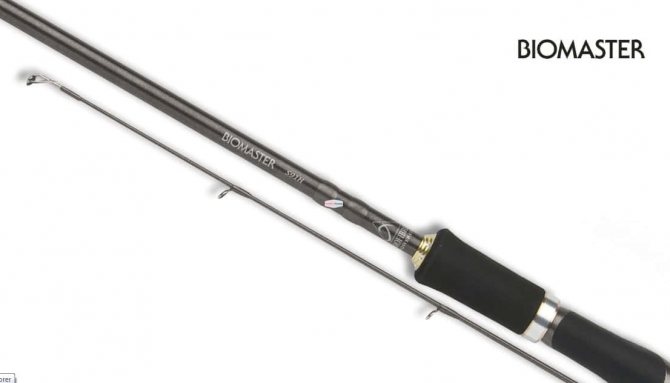
Many fishermen are frightened by the fact that such a fishing rod has an impressive weight and length, but most of the time it will stand on a stand, so heavy weight is not a problem, and besides, it is up to thirteen meters long, so it will allow you to fish at maximum speed. long distances.
In general, choosing a fishing rod for catching grass carp should not pose any difficulties. All fishing rods except ultralight ones are suitable for this. Using a match fishing rod is convenient if a fisherman wants to catch grass carp weighing up to 2 kilograms.
How and what to feed?
You need to prepare carefully for fishing. The tackle must be strong; a carp rig with a long leash and a heavy sinker attached is ideal for these purposes. As bait you can use poppy seed with corn, algae with a thread structure, flavored boilies or dandelion leaves.
When you arrive at the fishing spot, you don’t need to first throw in complementary food - this will only scare the wary fish. First of all, it’s better to quietly cast the tackle, catch several fish, and only then start giving complementary foods.
There is no need to constantly add complementary foods in huge portions; on the contrary, in the second half of the day the food thrown into the water should be reduced.
If the fisherman’s target is a large individual, then the tackle needs to be thrown 10-15 m further from the feeding area. This is explained by the fact that the big fish does not swim next to the rest of the school, it prefers to stay away from it.
Cupid can also be caught in the center of the bait, but here the individual will be smaller. As complementary food, you can use oatmeal or corn flakes available in every home.
Fishing technique and tactics
You need to catch fish on a warm autumn or spring day, and there must be sun in the sky, but the wind is completely unsuitable for such fishing. It bites more in the first half of the day, before the sun leaves the horizon.
Grass bait
Cupid is a very cautious fish, so don’t make noise . Different types of bait can even be folded in several layers to make a kind of sandwich, for example, boiled potatoes, pea leaves and the like. All bait ingredients are first put on a green thread, which is then tied to the hook.
Despite the herbivory known to the general public, sometimes this fish individual is not at all averse to trying the meat, so you can also attach an earthworm to the hook.
Tips from experienced fishermen
Blue field workers with extensive experience, who have already caught more than one cupid in their lives, advise:
- Be sure to use a bite activator. This modern mixture, due to the pheromones it contains, will increase the appetite of the fish.
- When fishing, use gear that is highly sensitive, so that even the slightest touch of a fish to the bait will not go unnoticed by the fisherman.
- When choosing bait, it is advisable to opt for those varieties that contain pheromones .
Composition of grass carp and its benefits
The meat has a low level of fat (5.2%) and high nutritional value due to the content of many useful substances:
- iron (0.37 mg), manganese (0.07 mg), zinc (0.98 mg);
- potassium (0.32 mg), phosphorus (0.26 mg), sodium (0.05 mg);
- magnesium (0.03 mg), calcium (0.025 mg), selenium (0.01 mg);
- vitamins of group B (6600 mcg), A (36.1 mcg), D (11.34 mcg);
- Omega 3 and 6 fatty acids (2.1 g);
- easily digestible proteins (18.6 g).
The calorie content of 100 g of fish is 125 kcal, which increases when frying to 167 kcal, and decreases when boiling to 108 kcal. Dishes made from grass carp are very useful for preventing wrinkles, vitamin deficiencies, heart and vascular diseases, visual disturbances, and problems with the nervous and digestive systems. In addition, selenium in fish fillet has a beneficial effect on the functioning of the thyroid gland and normalizes hormonal levels.
